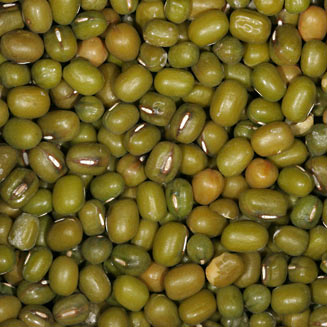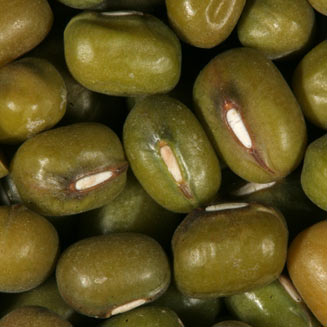|
Vigna radiata (Mung bean, Green gram, Golden
gram, Chop suey bean, Chickasaw pea)
[= Phaseolus aureus] Life
> eukaryotes >
Archaeoplastida >
Chloroplastida
>
Charophyta > Streptophytina > Plantae (land plants)
> Tracheophyta (vascular plants) > Euphyllophyta > Lignophyta (woody plants)
> Spermatophyta (seed plants) > Angiospermae (flowering
plants) > Eudicotyledons > Core Eudicots > Rosids >
Eurosid I > Fabales > Family: Fabaceae > Subfamily: Papilionoideae
> Genus: Vigna
 |
 |
|
Mung beans. [photos H. Robertson, Iziko
©] |
Mung beans originate from India and India remains a
leading producer of this legume. Most mung beans are olive green in colour but
they can also be yellow, brown, or mottled black. They are an excellent source
of folic acid and a good source of magnesium, phosphorus and thiamin. Mung
beans are an important food in rural areas of southern Africa, where the dry
bean seeds are used or the beans themselves are eaten as a vegetable.
Uses
- Most commonly grown as bean sprouts, which are eaten raw.
They are often added to salads or to a stir-fry.
- Whole beans can be eaten after about an hour of
cooking. They don't need to be soaked beforehand.
- Beans are ground into flour and this is used to make
noodles, which are termed 'bean threads' or 'cellophane noodles'
- Breads and pastries can be filled with puréed mung
beans.
- In India, they make a spread called 'moog dal', which
is eaten with rice or bread.
- Young, whole beans are eaten as a vegetable.
How to make bean sprouts
- Buy a bag of mung bean seeds from the
supermarket of health shop.
- Put about two tablespoons of bean seeds
into a glass jar.
- Add lots of lukewarm water to the jar,
cover it with a porous cover such as gauze or muslin and let the
seeds soak overnight. This process helps them to germinate more
quickly.
- The next day, drain off the water with
the help of the porous cover. Put the jar in a warm place with
good ventilation, out of direct sunlight. A temperature of
13-21°C is ideal.
- Over a period of 5-7 days, every night
and morning pour warm water over the seeds and then turn the jar
over and drain the water away using the porous cover as a sieve.
If they are not drained properly, fungus can develop. However,
if you are too vigorous in draining the water, you can damage
the sprouts and stop them growing.
- At the termination of this growing
period, give the sprouts a final rinse. If not eaten
immediately, they can be stored in the fridge for about four
days. When storing them in the fridge, place them on an
absorbant surface such as a layer of roller towel (to absorb
excess moisture), in an airtight container.
information from
Brown (1991) |
Publications
-
Anon. 2002. Encyclopedia of Foods. A Guide
to Healthy Nutrition. Academic Press, San Diego, California.
-
Brown, S. 1991. Vegetarian Cookery
(Pocket Encyclopedia). Dorling Kindersley, London.
-
van Wyk, B.-E. & Gericke, N. 2000. People's
Plants. A Guide to Useful Plants of Southern Africa. Briza Publications,
Pretoria.
|
